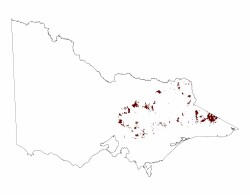1.2.1 Plateaux and broad ridges (Straghbogie, Koetong-Shelly, Errinundra, Kinglake, Olinda)
1. Eastern Uplands (EU)
1.2.1 Plateaux and broad ridges (Straghbogie, Koetong-Shelly, Errinundra, Kinglake, Olinda)
1.2.2 Enclosed landscapes of low relief (Fraser Tableland, Benambra)
| This Tier includes extensive areas of low relief at elevations from 500–1200 m on a range of rock types. The Koetong – Shelley area (600-800 m) is on granite, the Beechworth – Stanley area (600-800 m) is on granite and Palaeozoic sedimentary rocks, the Toombullup – Tolmie plateau (700-900 m) is on Devonian rhyolite/rhyodacite. The Wabonga plateau on the eastern side of the King River (Drum Top – Mount View) is on Carboniferous sedimentary rocks and the dissected plateau of the Strathbogie Ranges is formed in granite. South of the Koetong-Shelly plateau on the eastern side of the Eastern Uplands, there are several plateaus at higher elevations formed in granite, including the Pinnibar plateau (c. 1 300 m), the most extensive of these. The dissected Errinundra Plateau (about 1 000 m) is the southern limit of the Monaro Tableland of NSW. It has formed on deeply weathered Palaeozoic mudstone and granite. Near the head of the Genoa River in the far east is a modified plateau formed mainly in Upper Devonian sandstone and granite. |  |
On the south-eastern side of the Region, the Kinglake plateau (about 600 m) is predominantly on deeply weathered Devonian sedimentary rocks.
The relationships of these surfaces to one another, and to the high-level plateaus has not been resolved.
The vegetation is usually an open forest of mixed eucalypts that include Narrow-leaf Peppermint, Candlebark Gum, Manna Gum, Victorian Blue Gum and occasionally Messmate Stringybark. On drier sites Red Stringybark, Broad-leaf Peppermint and Red Box may replace those communities that have higher moisture requirements. A low understory of sclerophyllous shrubs is usually present. Tall forests of Alpine Ash occur on the Pinnibar plateau that is higher than the others.
Soils in these landscapes are generally red and brown gradational soils (Dermosols). Sometimes red and brown texture contrast soils (Kurosols) occur where it appears they may be two-layered soils i.e. the A-horizon appears to be a layer of transported material rather than being formed by profile differentiation. The generally low relief has allowed deep weathering of the regolith to proceed without significant surface stripping that exposes less-weathered and more-stony parent material. On steeper slopes where this has occurred, soils are likely to be shallow, weakly-structured gradational soils (Kandosols).


